Table of Contents
- Introduction
- Editor’s Choice
- Global Mobile Internet Penetration
- Mobile Internet Usage Devices and Platforms Statistics
- Mobile Internet Traffic and Data Consumption Statistics
- Mobile Internet Usage Apps and Patterns Statistics
- Country-wise Mobile Internet Usage Statistics
- Future Trends in Mobile Internet Usage
- Recent Developments
- Conclusion
- FAQs
Introduction
Mobile Internet Usage Statistics: Mobile internet usage refers to accessing the internet through mobile devices. Such as smartphones, tablets, and other portable gadgets equipped with wireless connectivity capabilities.
It has become an integral part of modern life, shaping how people communicate. More access to information, shop, entertain themselves and conduct various online activities.
Mobile internet usage has revolutionized how individuals access information, communicate, shop, and engage with online content.
Its widespread adoption has led to significant changes in various industries and has become an integral part of daily life for people worldwide.
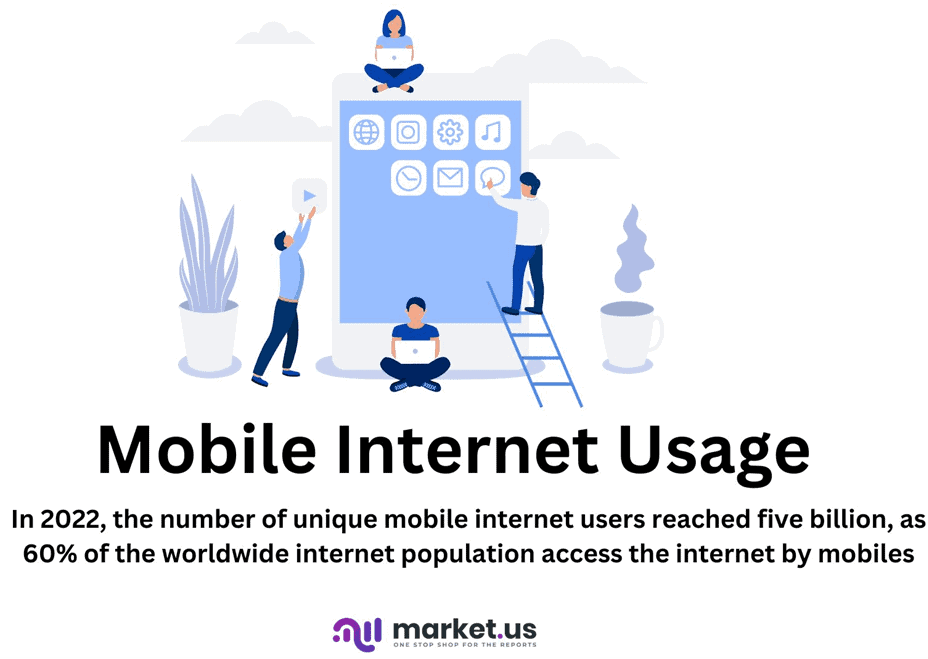
Editor’s Choice
- The Global Standalone 5G Network Market is anticipated to create a lucrative growth opportunity in the global landscape by registering a CAGR of 51.6% from 2024 to 2033.
- The market is expected to reach a valuation of USD 1,672.1 Million by the end of 2023 and is predicted to reach USD 1,07,214.7 Million by 2033.
- In 2022, the number of unique mobile internet users reached five billion. Suggesting that more than 60% of the worldwide internet population accesses the internet via a mobile device.
- As of 2023, the global population stood at 8.01 billion, with smartphone users continuing to grow, reaching 6.92 billion.
- In July 2022, Android commanded the majority mobile operating system share at 71.85%, followed by iOS at 27.5%.
- By the conclusion of 2022, worldwide mobile data traffic, excluding traffic originating from Fixed Wireless Access (FWA), had reached 93 exabytes (EB) every month.
- Projections indicate that this volume is anticipated to expand significantly. Growing by a factor of 3.5, and is projected to achieve 329 EB per month by 2028.
- With an impressive 672 million downloads, TikTok is one of the most downloaded apps.
- The global landscape of 5G mobile connectivity is marked by varying degrees of adoption across different countries. Reflecting the rapid evolution of telecommunications technology. Leading the charge is China, boasting an impressive 866 million 5G mobile connections. Which constitute 51% of its total mobile connections.
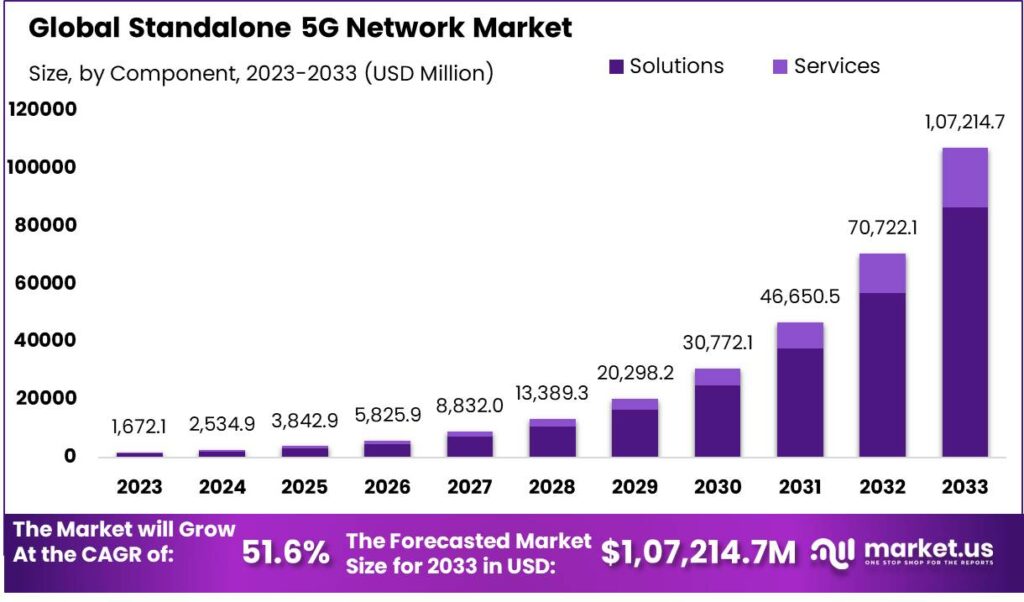
Global Mobile Internet Penetration
- In 2022, the number of unique mobile internet users reached five billion. Suggesting that more than 60% of the worldwide internet population accesses the internet via a mobile device.
- During the second quarter of 2022, global consumers spent more than half of their internet time on mobile phones.
- As of the beginning of the third quarter of 2023, approximately 5.19 billion individuals worldwide were using the internet. Accounting for roughly 64.5% of the global population.
- The expansion of internet users remains ongoing, and the most recent statistics reveal that the world’s connected population. Expanded by over 100 million users in the twelve months leading up to July 2023.
- While this growth rate of slightly above 2% for the year-on-year period is notable. It is notably more gradual than the rapid growth rates in the mid-2010s.
- The distribution of internet traffic originating from mobile phones has fluctuated over the years. 2017 mobile phones contributed to 54.09% of internet traffic, slightly decreasing to 53.01% in 2018.
- The trend continued in 2019 with a share of 52.26%, but in 2020, it saw a modest rise to 53.07%
- A significant shift occurred in 2021 when mobile phones accounted for 56.53% of internet traffic, reflecting a notable increase.
- The trajectory further ascended in 2022, reaching 59.66%. However, in 2023, there was a slight dip, with mobile phones generating 56.86% of internet traffic. These variations demonstrate the evolving role of mobile phones in internet usage and their impact on overall online activity.
(Source: Statista, Digital 2023 July Global Statshot Report, Oberlo)
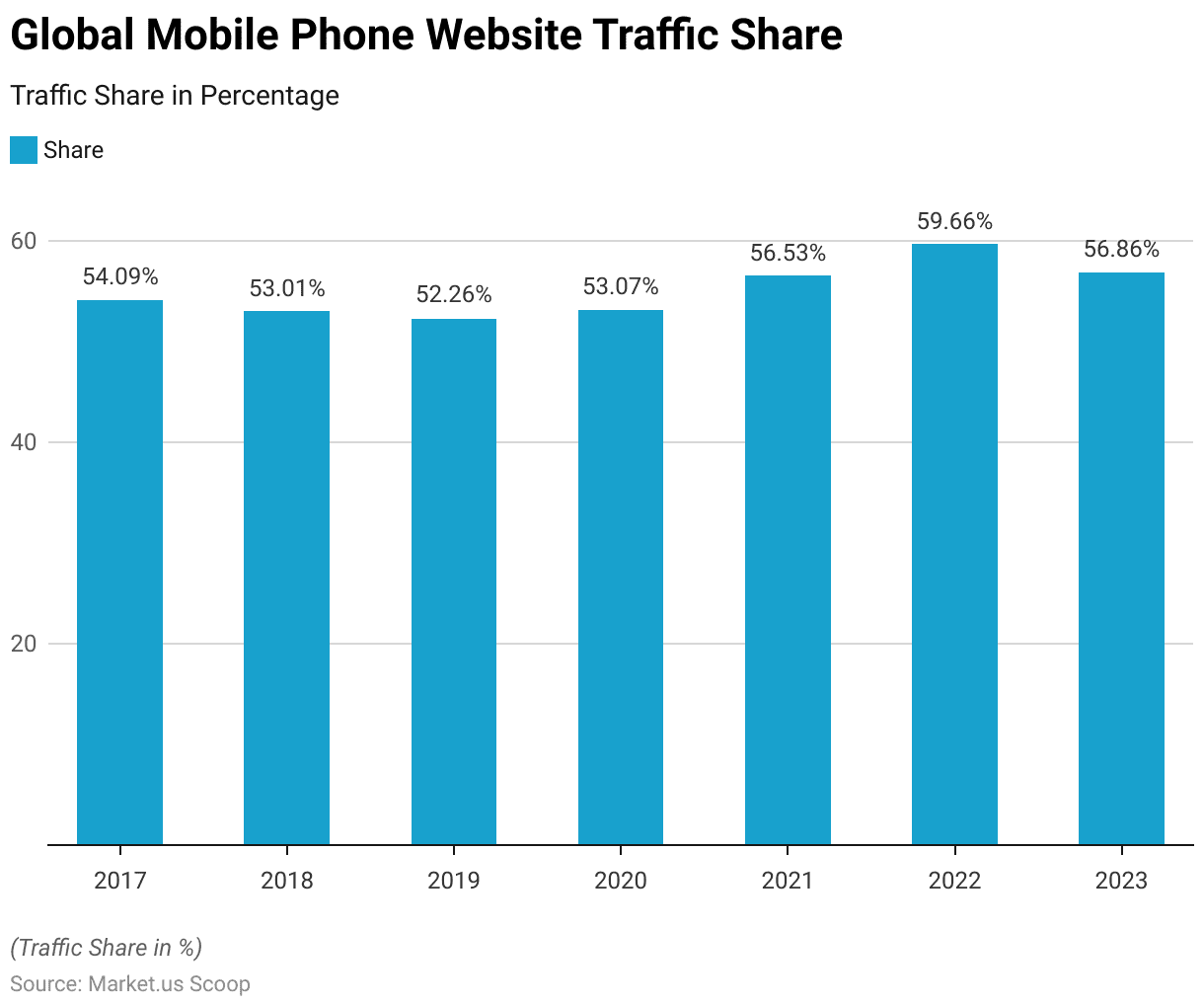
Mobile Internet Usage Devices and Platforms Statistics
Smartphone Ownership and Usage
- From 2018 to 2023, the global landscape witnessed a progressive rise in population numbers and smartphone usage.
- In 2018, the global population stood at approximately 7.63 billion, while smartphone users amounted to 5.09 billion.
- This trend continued to gain momentum over the subsequent years. In 2019 recorded a population of 7.71 billion and 5.64 billion smartphone users.
- By 2020, these numbers climbed to 7.79 billion in population and 6.05 billion smartphone users.
- The upward trajectory persisted into 2021, when the global population reached 7.87 billion, while smartphone users surged to 6.38 billion.
- In 2022, the trend remained consistent, with a global population of 7.9 billion and a significant rise to 6.65 billion smartphone users.
- As of 2023, the global population stood at 8.01 billion, with smartphone users continuing to grow, reaching 6.92 billion.
- The smartphone industry continues to offer substantial room for expansion. The prevalence of smartphones remains below 70% in numerous densely populated markets, notably in China and India.
- In 2021, the worldwide revenue generated by smartphones amounted to 481 billion U.S. dollars. However, it was projected to experience a decline to 463 billion dollars in 2022.
(Source: Statista)
Mobile Operating Systems Market Share
- As of 2022 and 2023, the distribution of mobile operating systems reveals distinct patterns. In July 2022, Android commanded the majority share at 71.85%, followed by iOS at 27.5%.
- Samsung held a modest share of 0.42%, while an unidentified category and KaiOS each accounted for 0.12% and 0.05%, respectively. Windows and Nokia both held marginal shares of 0.02% and 0.01%.
- By October 2022, Android retained its dominance but slightly decreased to 70.98%, while iOS increased to 28.41%.
- Samsung’s presence declined to 0.33%, Nokia’s grew to 0.15%, and KaiOS and Windows remained at 0.07% and 0.02%.
- By December 2022, Android rebounded to 72.37%, and iOS decreased to 26.98%. Samsung’s share rose to 0.36%, with an unidentified category, KaiOS, Windows, and Nokia, each maintaining their respective shares of 0.13%, 0.11%, 0.02%, and 0.01%.
- These trends continued into 2023. In January, Android had 71.77%, iOS stood at 27.6%, and Samsung reached 0.34%. Android decreased to 68.61% in April, and iOS rose to 30.61%. Samsung reached 0.42%, while the unidentified category and KaiOS grew to 0.17% percent and 0.12% percent.
- Both Windows and Nokia remained at 0.02% and 0.01%.
- Android increased to 70.87% in July, and iOS was at 28.39%. Samsung, Unidentified, and KaiOS each held 0.38%, 0.15%, and 0.15%. While Windows and Nokia maintained their shares of 0.02% and 0.01%.
(Source: StatCounter)
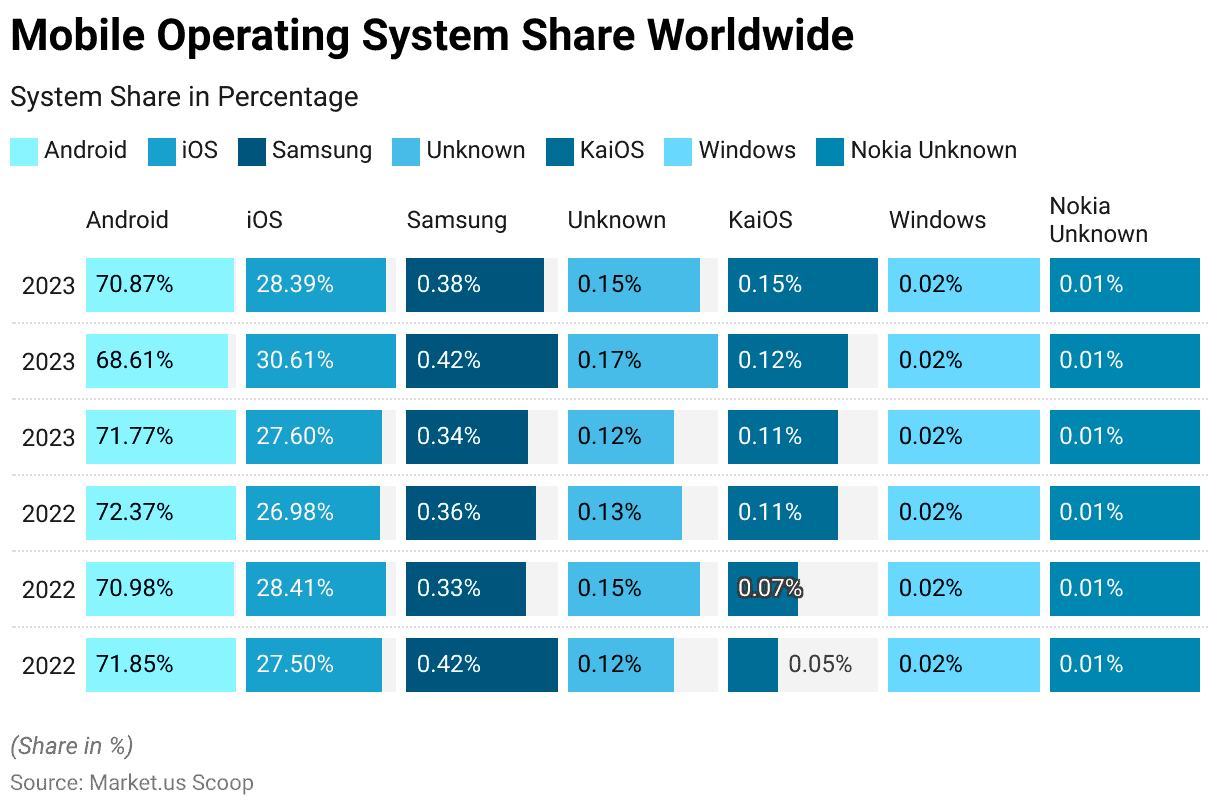
Tablet and Other Mobile Internet Device Usage Statistics
- The global tablet user base surpasses 1.28 billion individuals, with Apple iPads reigning as the dominant choice globally.
- Projections indicate that tablet shipments are set to achieve 156 million units by 2025.
- Email usage is the primary purpose of utilizing these devices Among the various functions. Notably, North America takes the lead in tablet deliveries. The collective revenue generated by intelligent devices amounted to nearly $60 billion worldwide in 2021.
- In the United States, the typical lifespan of tablets experienced a reduction from 7 to 5 years.
- The global tablet market exhibited remarkable growth, surging from $71.58 billion in 2021 to an impressive $84.84 billion in 2022.
- Generation X and Millennials have emerged as the predominant users of tablet devices. Approximately 22-23% of tablet users leverage these devices to watch movies and videos and send emails.
(Source: Statista)
Mobile Internet Traffic and Data Consumption Statistics
Mobile Internet Data Usage Traffic Growth Statistics
- Over the last seven years, internet traffic from mobile devices has exhibited notable fluctuations.
- Starting at 50.03% in Q1 2017, it saw a substantial increase of 26.75% in the subsequent year.
- The upward trend continued, albeit slower, with a rise of 3.48% in Q1 2018.
- However, a reversal occurred in Q1 2019, as the share dropped to 48.71%, representing a decrease of 5.91%.
- Rebounding from this dip, the share regained momentum and reached 51.92% in Q1 2020, marking an increase of 6.59%.
- The positive trajectory persisted in Q1 2021, with the share climbing to 54.80% (an increase of 5.55%) and further advancing to 59.66% in Q1 2022 with a 4.86% rise.
- The most recent data point, Q1 2023, continued this pattern, with the share expanding to 60.89%, reflecting a 1.23% increase.
(Source: StatCounter, DataReportal)
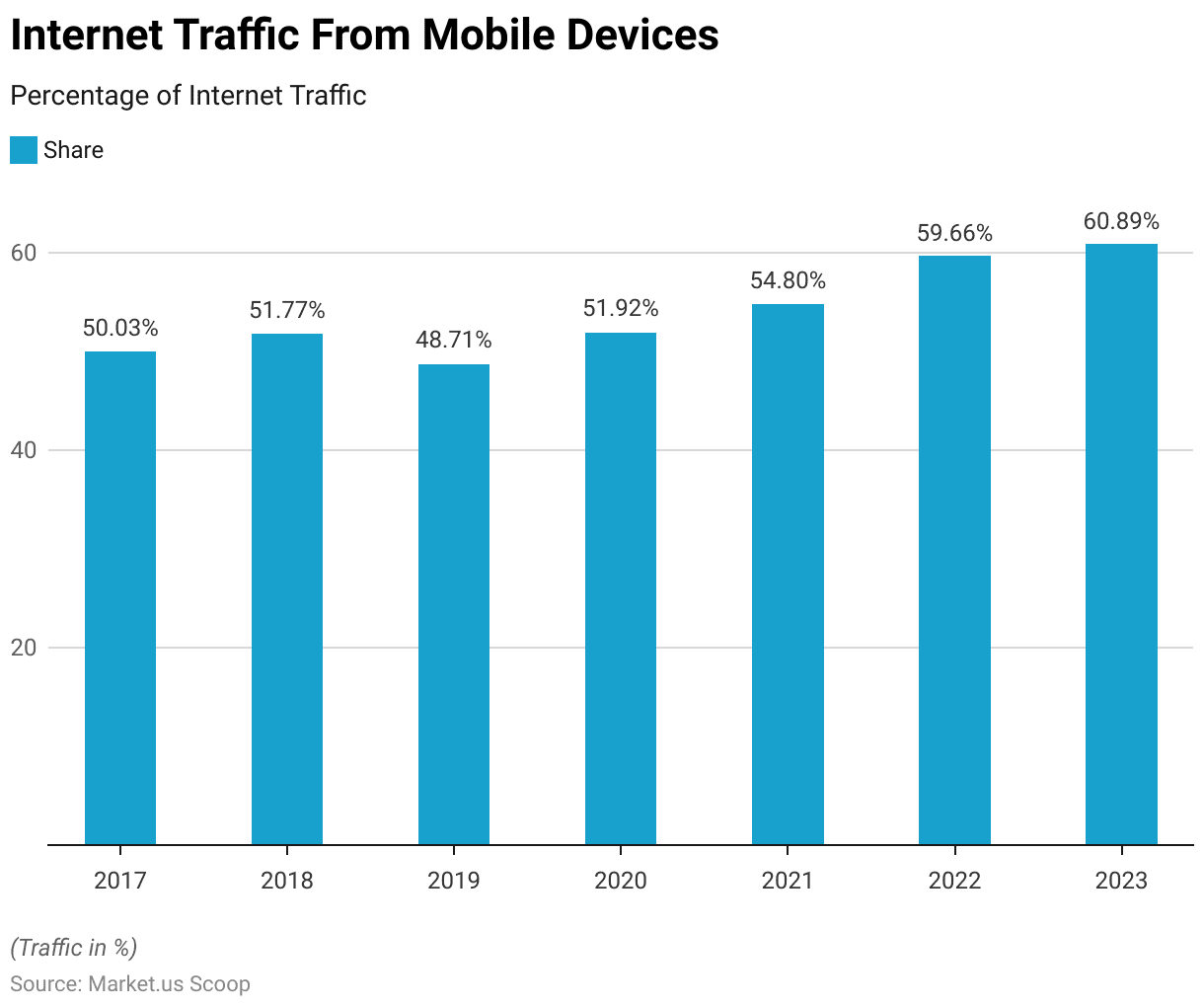
Per-smartphone Mobile Internet Data Usage Statistics
- Over the projected timeframe from 2022 to 2028, diverse regions worldwide are anticipated to experience varying growth trajectories regarding their per-smartphone mobile data usage. As indicated by their respective compound annual growth rates (CAGR). In Latin America, there is a substantial expected expansion. The usage is predicted to surge from 11 to 41, reflecting a notable CAGR of 25%.
- Similarly, North America is poised for significant advancement. Its usage is set to elevate from 20 to 58, translating to a CAGR of 20%.
- Western Europe follows suit with projected growth from 20 to 56, at a CAGR of 19%, while Central and Eastern Europe are expected to progress from 14 to 37, representing an 18% CAGR.
- North-East Asia and South East Asia & Oceania exhibit parallel growth patterns. Each is anticipated to grow from 18 to 54, resulting in a CAGR of 20% and 24%, respectively.
- The Indian subcontinent, encompassing India, Nepal, and Bhutan, is predicted to gradually expand from 26 to 62, yielding a CAGR of 16%.
- Meanwhile, the Middle East & North Africa region is projected to grow from 12 to 37, reflecting a CAGR of 20%. Sub-Saharan Africa displays significant growth potential. With its usage is expected to increase from 4.7 to 19, indicating a substantial CAGR of 26%.
- The Gulf Cooperation Council (GCC) region, on the other hand, is poised for a more moderate progression, from 26 to 59, at a CAGR of 15%.
- Considering the global perspective, the overall per-smartphone mobile data usage is forecasted to grow from 16 to 47, reflecting a CAGR of 20% across the covered period.
(Source: Ericcson)
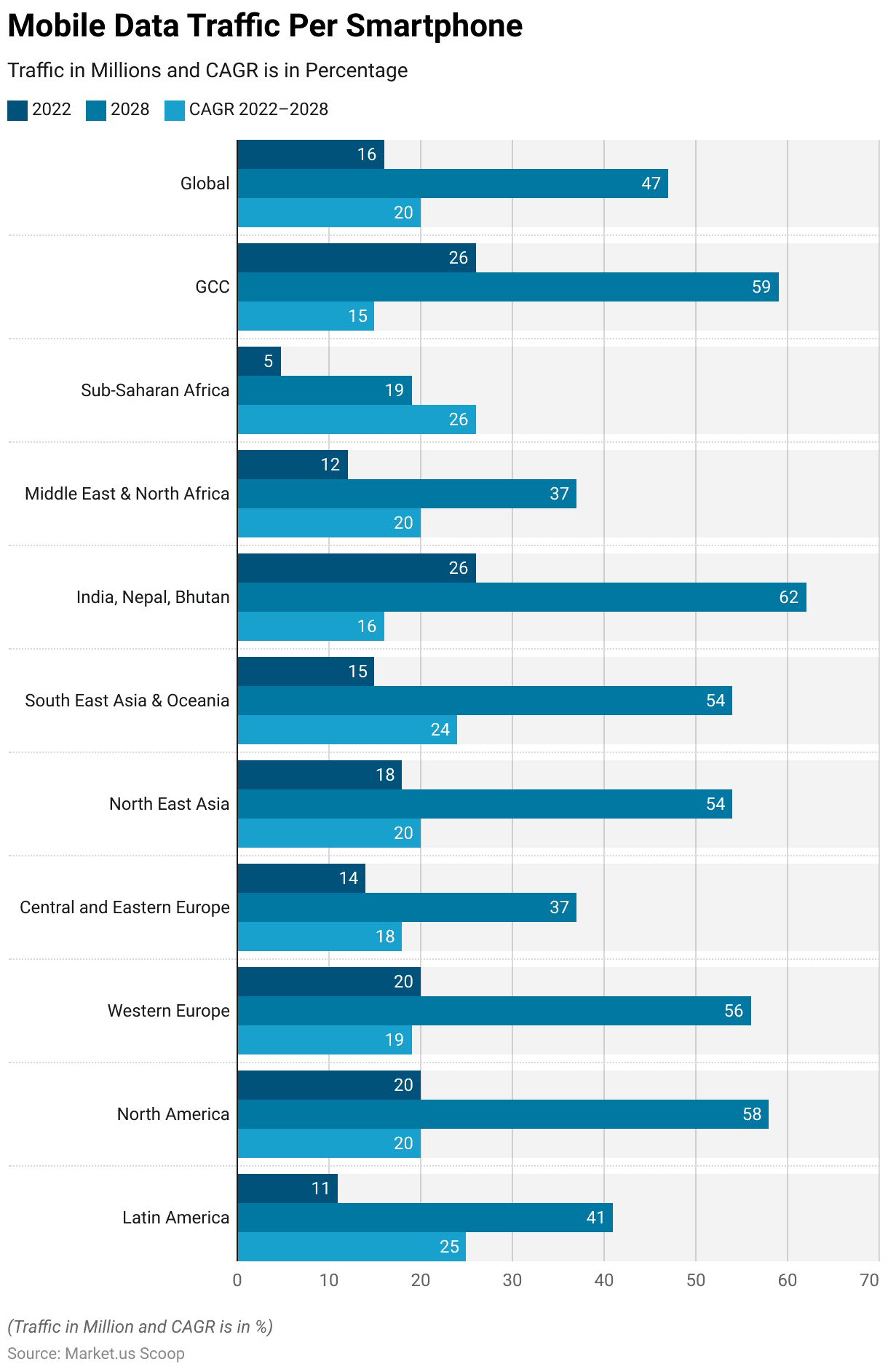
Mobile Internet Usage Apps and Patterns Statistics
Mobile Internet Usage for Most Downloaded Mobile Apps Statistics
- The popularity of various mobile applications is evident from their download figures, measured in millions (mm). Leading the pack is TikTok, with an impressive 672 million downloads, making it one of the most downloaded apps.
- Not far behind is Instagram, boasting 548 million downloads, while Facebook follows closely with 449 million.
- WhatsApp also commands a significant user base, with 424 million downloads.
- CapCut, a video editing app, has garnered attention with 357 million downloads. While Snapchat remains relevant with 330 million downloads.
- Telegram, an instant messaging app, has secured 310 million downloads.
- Gaming apps also make their mark, with Subway Surfers racing to 304 million downloads and Stumble Guys stumbling upon 254 million.
- The musical realm is represented by Spotify, with 238 million downloads. Showcasing the broad spectrum of user interests and preferences within the app landscape.
(Source: Apptopia)
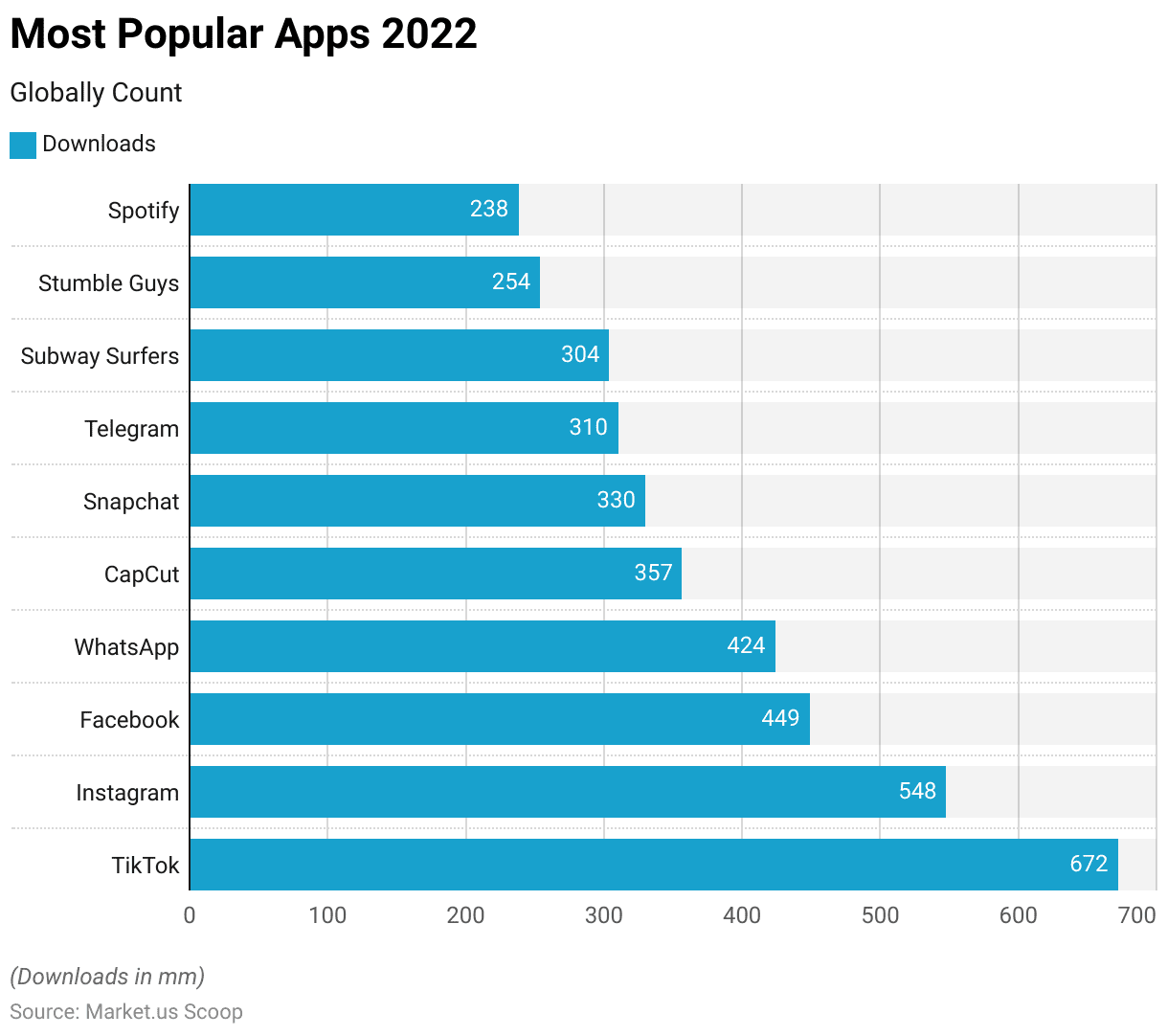
Mobile Internet Usage for E-commerce and Shopping Statistics
- The adoption of e-commerce among online populations varies across different countries, revealing intriguing insights into consumer behavior. Leading the charge is Indonesia, where 79.10% of the online population engages in e-commerce activities.
- Thailand closely follows with 74.20%, while the Philippines showcases a substantial 69.60% e-commerce adoption rate.
- Malaysia is 68.40%, while Saudi Arabia exhibits a robust 65.10%.
- In China, renowned for technological advancements, 64.30% of the online population participates in e-commerce.
- Taiwan and Vietnam also demonstrate notable adoption rates at 63.80% and 61.40%, respectively.
- South Korea maintains a healthy 59.90%, and India, with its vast online user base, is 57.30%.
- Singapore rounds out the list, with 56.90% of its online population engaging in e-commerce activities.
(Source: Mobile Ecosystem Forum, Data Reportal)
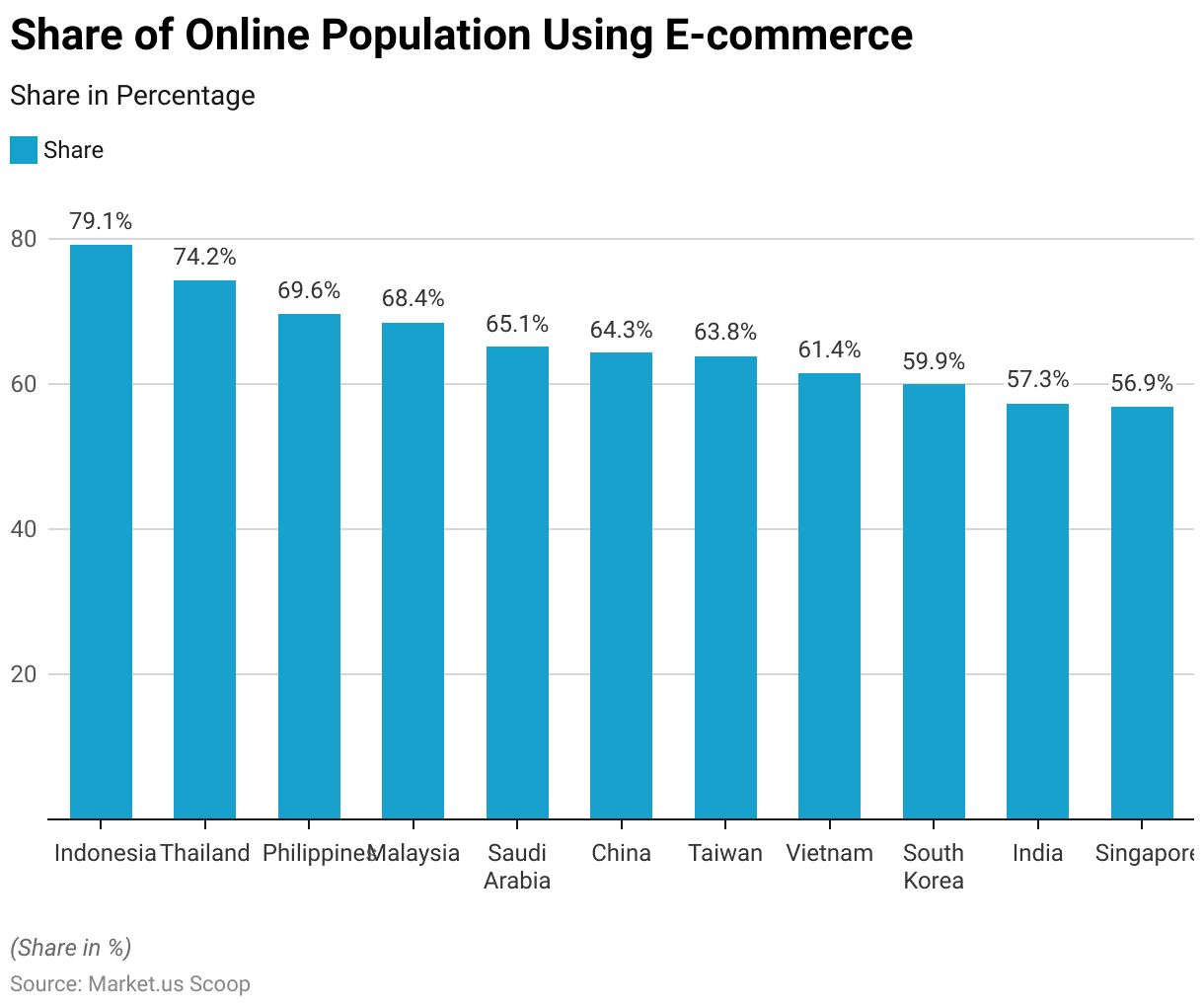
Country-wise Mobile Internet Usage Statistics
China
- China is a global frontrunner in smartphone adoption and mobile connectivity, boasting an impressive user base. By June 2022, approximately 1.05 billion individuals had embraced mobile internet services in the country, constituting 73% of its population.
- Despite a decade of robust growth in the mobile economy, China’s expansion of mobile internet users has tapered off in recent years. In parallel, the maturity of the 4G mobile network has prompted China to intensify its shift toward 5G integration.
- Remarkably, over 350 Chinese cities have already implemented 5G availability, leaving the United States considerably behind.
- The swift transition to 5G is equally evident on the user side, with the tally of 5G end users surpassing 450 million by the close of 2021.
- By 2025, 5G is projected to encompass 47% of total connections, accommodating a staggering 1.28 billion users.
- By September 2022, nearly three of every five mobile internet users were in China’s tier-3 cities and less developed regions. Compared to urban counterparts, these areas exhibit fewer financial constraints and more leisure time. Fostering heightened engagement in social networking, mobile commerce, and video streaming.
- Concurrently, China is grappling with an aging population. Leading to a steady rise in internet users aged 60 years or older, projected to reach 100 million by 2025.
- Regarding consumer behavior, Chinese mobile phone users now dedicate more time to consuming short videos than engaging in instant messaging.
- Moreover, the driving forces in the market landscape will remain live streaming commerce, eSports streaming, and mobile gaming. The emergence of virtual reality (VR) and augmented reality (AR) technologies promises to elevate these experiences further.
(Source: Statista)
Japan
- In 2022, Japan had an estimated count of around 116.4 million individuals using mobile internet services.
- This number was anticipated to culminate in 2024 before experiencing a decline, settling at roughly 116 million by 2027.
- Concurrently, the overall populace of Japan was projected to diminish from approximately 125.2 million in 2022 to approximately 122.1 million by 2027.
- In Japan, the median mobile internet connection speed achieved through cellular networks is 40.89 Mbps. While the median speed for fixed internet connections is 93.26 Mbps.
- Over the year leading up to the beginning of 2022, Japan’s median mobile internet connection speed improved by 11.63 Mbps, marking a substantial growth of 39.7%.
- Simultaneously, fixed internet connection speeds in the country observed an advancement of 17.96 Mbps, representing a notable increase of 23.9% during the corresponding timeframe.
- As of the beginning of 2022, Japan boasted 202.1 million cellular mobile connections.
- Remarkably, the number of mobile connections in the country equated to 161% of the population as of January 2022.
- During the transition from 2021 to 2022, the count of mobile connections in Japan registered a growth of 5.3 million, signifying a notable increase of 2.7%.
(Source: Statista, Oakla, GSMA Intelligence)
India
- The number of mobile internet users has substantially evolved over the years in India. In 2010, 177.53 million users were engaging with mobile internet services.
- By 2015, this number had surged significantly to 694.77 million, reflecting considerable growth.
- As of 2020, the count escalated to 1,055.39 million, underlining the remarkable expansion of mobile internet adoption.
- Looking ahead, projections indicate a gradual increase in the years to come. By 2025, the number of mobile internet users is anticipated to be 1,062.01 million, with a further uptick to 1,100.95 million by 2030.
- The trajectory continues upward, with estimations of 1,138.69 million users in 2035, 1,169.59 million in 2040, and 1,196.21 million in 2045.
- As the timeline extends to 2050, the projected mobile internet users will reach 1,214.28 million.
- In India, the median mobile internet connection speed achieved through cellular networks is 14.39 Mbps, while the median speed for fixed internet connections is 47.40 Mbps. Over the year leading up to the beginning of 2022, India’s median mobile internet connection speed saw a notable improvement of 5.15 Mbps, reflecting a substantial growth of 55.7%.
- In India, the median mobile internet connection speed achieved through cellular networks is 14.39 Mbps, while the median speed for fixed internet connections is 47.40 Mbps.
- For the year leading up to the beginning of 2022, India’s median mobile internet connection speed saw a notable improvement of 5.15 Mbps, reflecting a substantial growth of 55.7%.
- As of January 2022, mobile connections in India corresponded to approximately 81.3% of the total population.
- During the period spanning from 2021 to 2022, the count of mobile connections in India experienced a growth of 34 million, marking a notable increase of 3.1%.
(Source: Statista, Oakla, GSMA Intelligence)
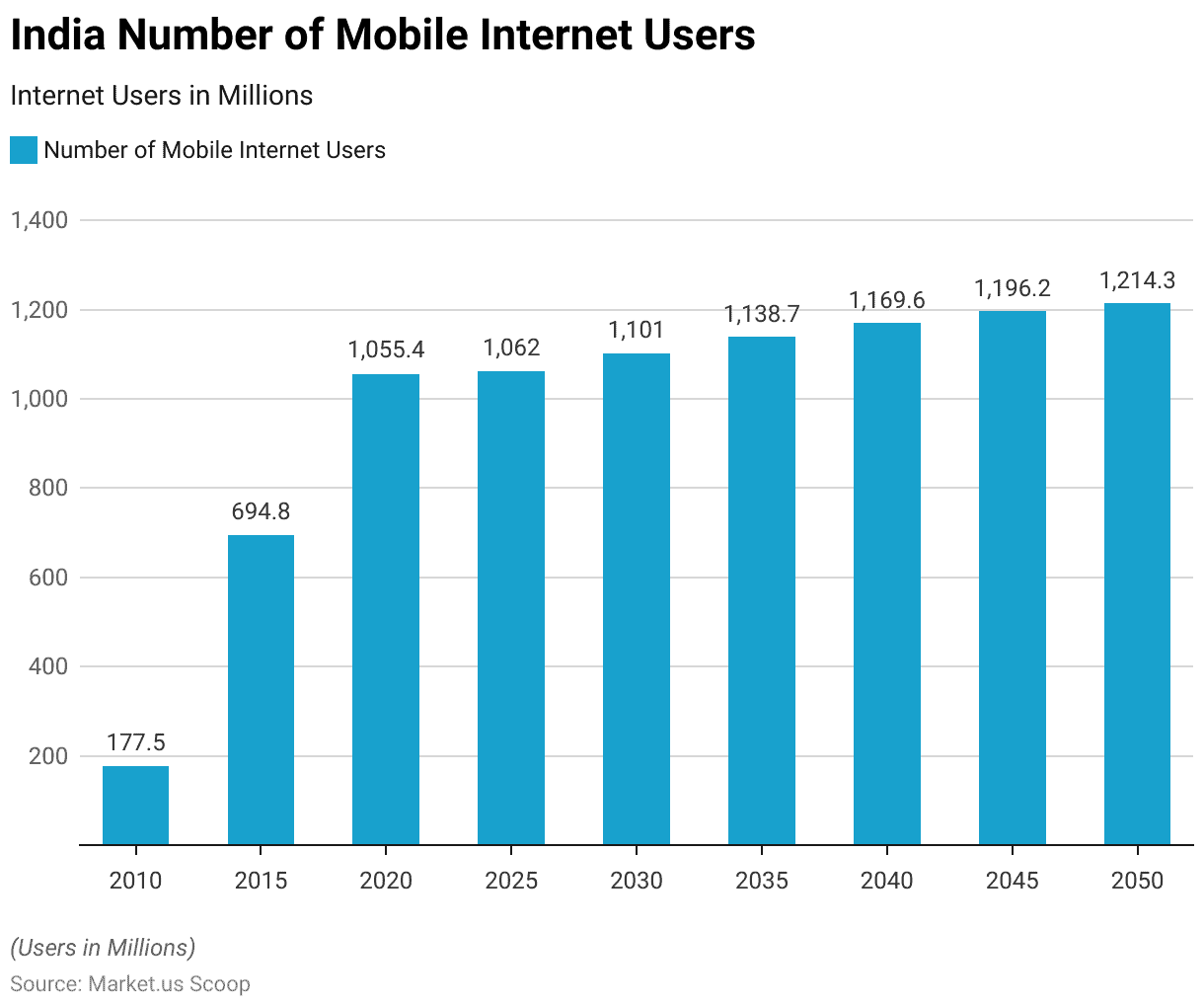
United Kingdom
- In 2022, the United Kingdom stood out among nations with its substantial mobile internet penetration, surpassing countries like the United States, Germany, and South Korea.
- Within the same year, the United Kingdom boasted a population of over 63.2 million mobile internet users, constituting a remarkable share of about 93% of the nation’s total populace.
- The outbreak of the global COVID-19 pandemic acted as a catalyst for accelerating trends in mobile usage, leading to UK users dedicating an average of more than four hours each day to their mobile devices in 2022.
- Given that a significant portion of this time was allocated to using internet-powered applications and browsing the web, the number of active mobile subscribers in the UK reached 97.2 million in 2021. This underscores a consistent and gradual pattern of growth that has been observed since 2007.
- By May 2022, approximately 25% of individuals in the United Kingdom indicated having access to 5G mobile service, while most utilized 4G service on their smartphones.
- It is anticipated that the proportion of 5G mobile connections in the UK will witness growth, reaching almost 60% by 2025.
- In March 2021, the digital demographic of the United Kingdom encompassed approximately 10.6 million distinct smartphone users aged 55 or above.
- Furthermore, smartphones were the preferred means to access the internet for teenagers and young adults. As of April 2022, younger users were more inclined to use smartphones for their daily online activities than computers or tablets.
- This trend was consistent among both genders: by December 2022, 97% of female internet users and 96% of male users in the UK accessed the internet via smartphones.
United States
- The trend observed in the distribution of internet usage between mobile devices and desktops in the United States over the past ten years follows an upward trajectory. The proportion of web traffic originating from mobile devices has experienced a significant upsurge.
- As of May 2023, the current scenario depicts that 67.81% of total web visits stem from mobile devices, while desktops account for 32.19%. However, over the recent years, there has been an exchange of positions between mobile and desktops, without a clear preference emerging as the primary browsing tool thus far.
- Among mobile internet browsers, Apple’s Safari has emerged as the preferred option for most mobile internet users in the US.
- Recent data indicates that 57.01% of all US mobile users opt for Safari to navigate the internet, with Google Chrome securing the second position at 36.78%.
- These statistics related to mobile browsing should not be unexpected, particularly considering the widespread adoption of iPhones in the US, where Safari is pre-installed on all iPhone devices. As it stands, there are approximately 124.7 million iPhone users in the United States.
(Source: Oberlo)
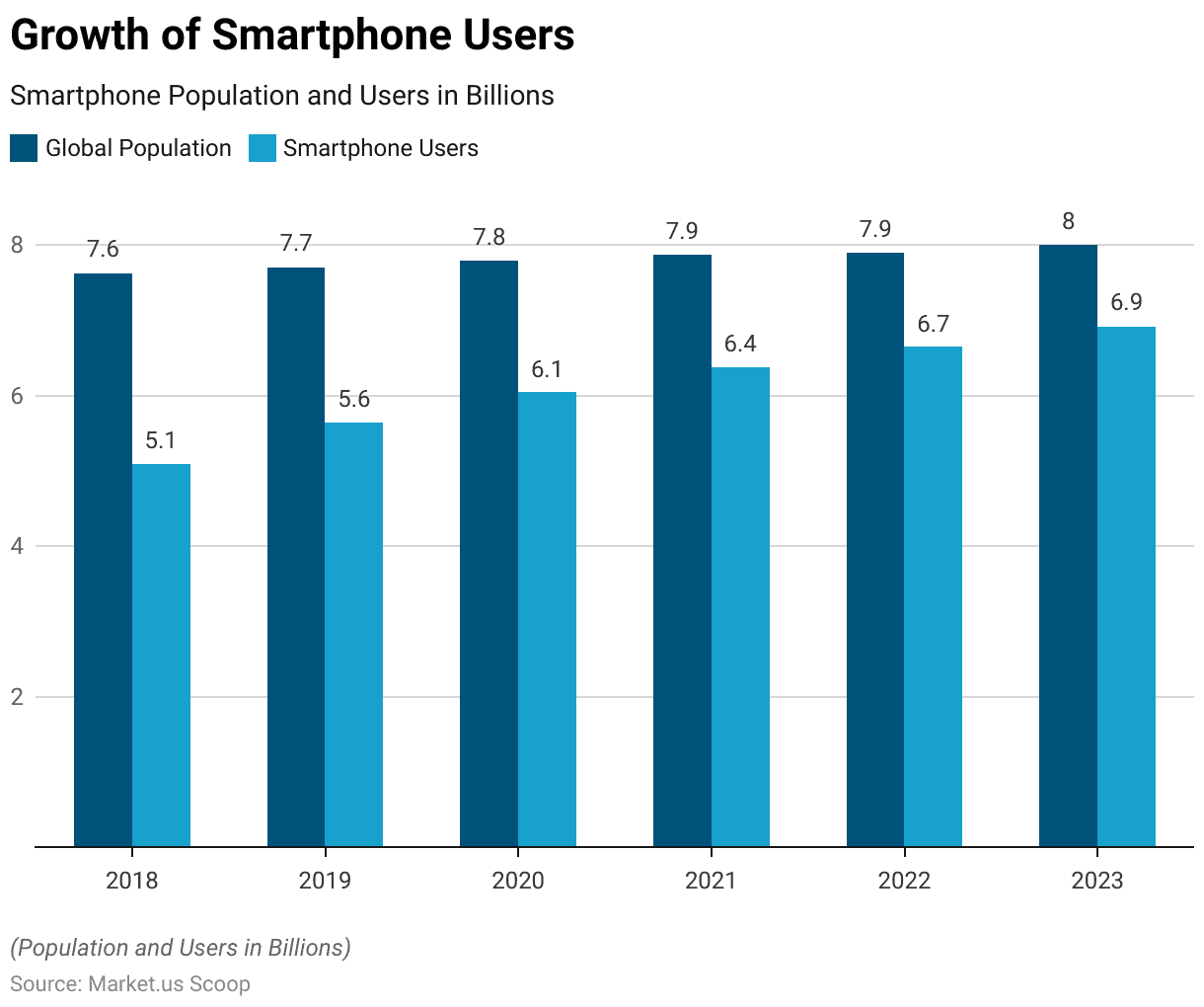
Future Trends in Mobile Internet Usage
5G Network Adoption and Impact
- The global landscape of 5G mobile connectivity is marked by varying degrees of adoption across different countries, reflecting the rapid evolution of telecommunications technology. Leading the charge is China, boasting an impressive 866 million 5G mobile connections, which constitute 51% of its total mobile connections.
- The United States follows suit with 247 million 5G mobile connections, representing 68% of its mobile connections.
- Japan and Germany showcase parallel trends, with both countries having 138 million 5G mobile connections, and 68% of their respective mobile connections attributed to this advanced technology.
- South Korea, renowned for its technological advancements, displays a remarkable 73% of mobile connections being 5G-enabled, accounting for 45 million connections.
- The United Kingdom and Germany maintain a steady pace with 42 million and 35 million 5G mobile connections, respectively, contributing to 57% and 49% of their mobile connections.
- Canada rounds off the list with 20 million 5G mobile connections, making up 51% of its total.
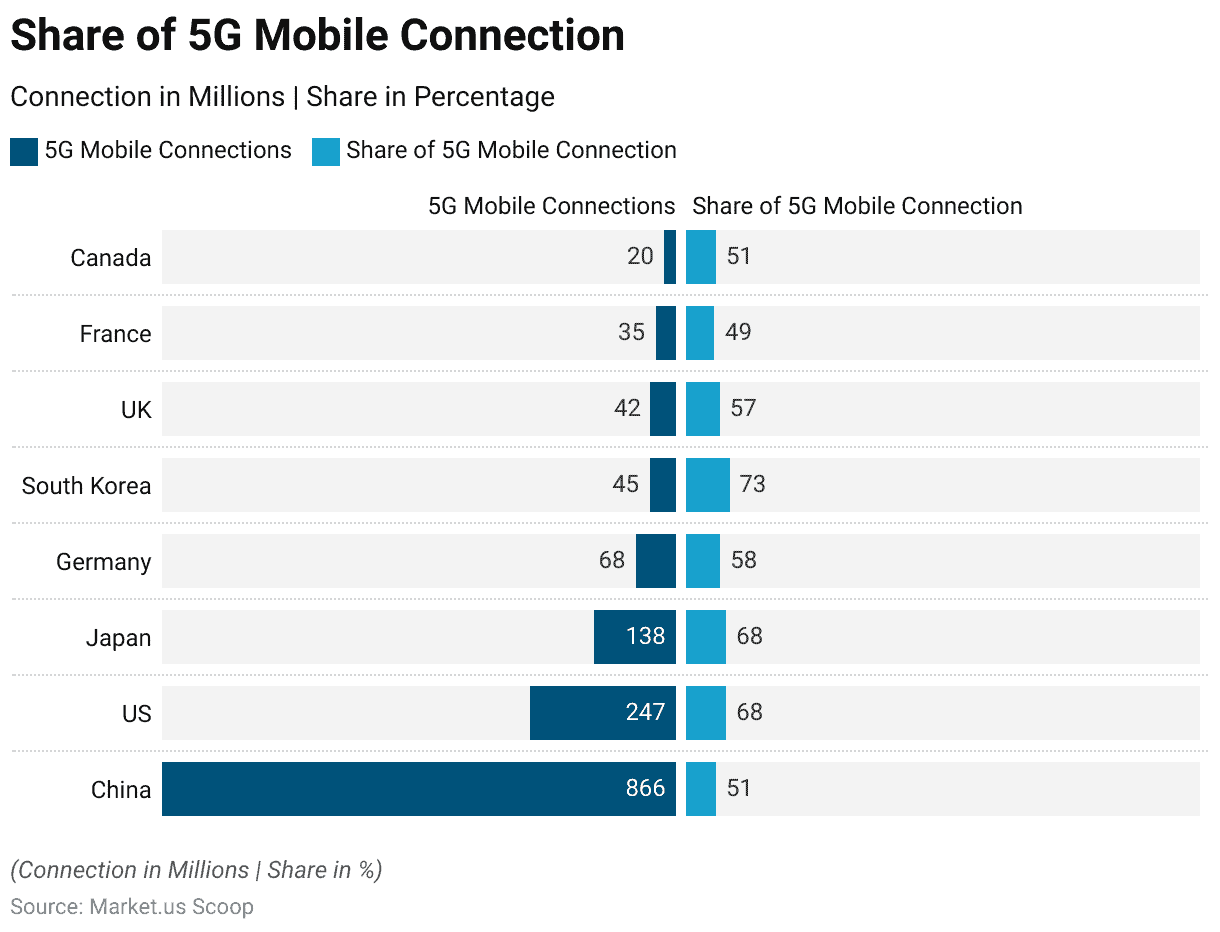
Recent Developments
Acquisitions and Mergers:
- Verizon acquires TracFone: In late 2023, Verizon completed its acquisition of TracFone Wireless for $6.25 billion. This move aims to expand Verizon’s prepaid customer base and enhance its mobile internet service offerings.
- T-Mobile merges with Sprint: The merger between T-Mobile and Sprint was finalized in mid-2023, creating a stronger competitor in the US mobile internet market with enhanced 5G coverage and increased network capacity.
New Product Launches:
- Apple iPhone 15 Series: Apple launched the iPhone 15 series in September 2023, featuring enhanced 5G capabilities and improved battery life, providing better mobile internet performance.
- Samsung Galaxy S24 Series: Samsung introduced the Galaxy S24 series in February 2024, with advanced 5G technology and new AI-powered features for improved mobile internet speed and user experience.
Funding:
- SpaceX’s Starlink raises $1.9 billion: In 2023, SpaceX raised $1.9 billion in funding to expand its Starlink satellite internet service, aiming to provide high-speed mobile internet access in remote and underserved areas globally.
- Google invests $1 billion in Africa: Google committed $1 billion in 2024 to enhance mobile internet infrastructure across Africa, focusing on improving connectivity and affordability.
Technological Advancements:
- 5G Network Expansion: The rollout of 5G networks continued to expand rapidly in 2023, with global 5G subscriptions reaching 1.5 billion by the end of the year, providing faster mobile internet speeds and lower latency.
- Wi-Fi 6 Adoption: Wi-Fi 6 technology is being increasingly adopted in smartphones and other mobile devices, offering improved internet speeds and more efficient connectivity in densely populated areas.
Market Dynamics:
- Increase in Mobile Internet Usage: Mobile internet usage saw a significant increase in 2023, with global mobile data traffic growing by 30% year-over-year, driven by the rise of remote work, online education, and streaming services.
- Growth in Mobile-First Markets: Emerging markets like India, Brazil, and Nigeria are experiencing rapid growth in mobile internet usage, with mobile-first users relying heavily on smartphones for internet access.
Regulatory and Strategic Developments:
- EU Digital Strategy: The European Union’s Digital Strategy, launched in 2023, aims to improve mobile internet infrastructure and promote digital inclusivity across member states, ensuring high-speed connectivity for all citizens.
- US Infrastructure Investment: The US government announced a $65 billion investment in 2023 to enhance broadband and mobile internet infrastructure, aiming to close the digital divide and provide high-speed internet to underserved communities.
Research and Development:
- Edge Computing: Ongoing R&D in edge computing is enhancing mobile internet performance by processing data closer to the user, reducing latency, and improving real-time application performance.
- AI and ML Integration: The integration of AI and machine learning in mobile networks is optimizing network management, improving user experience, and enabling predictive maintenance to prevent outages.
Conclusion
Mobile Internet Usage Statistics – Mobile internet usage has experienced substantial growth globally, driven by the widespread ownership of smartphones.
This trend has led to increased data consumption, with mobile apps such as social media, video streaming, messaging, and e-commerce playing a central role in users’ online experiences.
Video streaming, in particular, has emerged as a significant data-consuming activity. Social media platforms continue to connect people on mobile devices.
While mobile payments and location-based services have further integrated online activities into users’ daily lives. The accessibility of mobile internet has also improved connectivity in remote and rural areas.
FAQs
Mobile internet usage refers to accessing the internet using mobile devices such as smartphones and tablets, often utilizing cellular data networks.
Billions of people around the world use mobile internet. The exact number varies by region and country.
The widespread adoption of smartphones, improved mobile network infrastructure, availability of data plans, and the convenience of on-the-go connectivity are significant drivers of mobile internet usage growth.
Streaming videos, using social media, browsing websites, online shopping, navigation apps, and playing games contribute to mobile internet data consumption.
Data consumption varies by app. For instance, video streaming apps can use several hundred megabytes per hour, while social media and messaging apps typically use less data.
Discuss your needs with our analyst
Please share your requirements with more details so our analyst can check if they can solve your problem(s)



